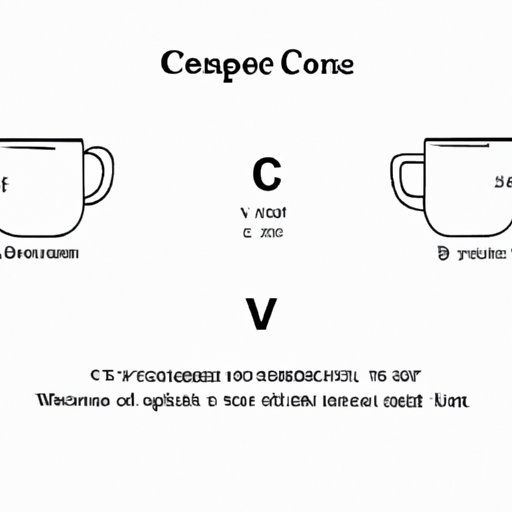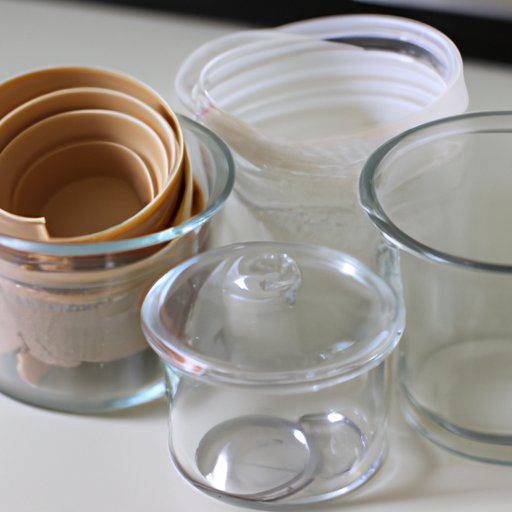I. Introduction
Many cooking and baking enthusiasts across the world have faced the challenge of converting measurements from cups to grams and vice versa. This can be a daunting task, especially when you are following a recipe from a different country or region. Understanding this common confusion and helping readers to solve this problem is the main purpose of this article.
II. Converting Cups to Grams: A Comprehensive Guide
Before converting measurements from cups to grams, it is important to understand what they are.
A. Definition of 1 cup
One cup is a measurement of about 250 ml or 8 fluid ounces. It is commonly used when measuring the volume of liquids, such as milk or water, or semi-solids, like yogurt or sour cream.
B. Definition of 1 gram
A gram is a basic unit of mass, equivalent to one-thousandth of a kilogram. It is commonly used to measure the weight of solids such as flour, sugar, or butter.
C. Conversion factors for different ingredients
The conversion factor from cups to grams varies depending on the ingredient being measured. Here is a general guideline for the most common cooking and baking ingredients:
1. Flour
1 cup of all-purpose flour weighs around 125 grams, while the same amount of cake flour weighs about 114 grams. Whole wheat flour weighs roughly 120 grams per cup.
2. Sugar
Granulated white sugar weighs around 200 grams per cup. Brown sugar is denser, so 1 packed cup of brown sugar weighs approximately 220 grams.
3. Butter
1 cup of butter is around 225 grams. It is essential to note that this conversion is for solid butter and not melted.
4. Milk
1 cup of milk weighs around 245 grams. Other liquid ingredients like water or juice can be measured in the same way.
5. Water
One cup of water weighs about 240 grams.
D. Importance of using accurate measurements
Accurate measurements are crucial for achieving consistent and perfect results. Even a slight variation in the amount of an ingredient can affect a recipe’s texture, taste, or overall outcome. A precise conversion of units is, therefore, critical in cooking or baking.
III. Eliminate Kitchen Confusion: How to Measure in Grams and Cups
Measuring ingredients in the kitchen doesn’t have to be a complicated task. Here are a few tips to help you measure your ingredients precisely.
A. Steps for measuring ingredients in grams
The first step to measuring in grams is to own a kitchen scale. Kitchen scales measure the weight of ingredients accurately, making the conversion from grams to cups incredibly easy. Simply weigh out the required amount of an ingredient in grams and note down the weight for future reference.
B. Steps for measuring ingredients in cups
To measure ingredients in cups, you need to use a reliable measuring cup. Fill the measuring cup with the ingredient’s desired amount, making sure to level it off with a flat object like a knife, so the measurement remains precise.
C. Benefits of using grams, especially in baking
Using grams to weigh ingredients has multiple benefits over using the traditional cups measurement. Firstly, grams provide greater accuracy and consistency than cups, which can have a considerable variance in interpreting measurements. Secondly, weighing ingredients in grams reduces the number of dirty dishes in your sink. Often, recipes measure liquids in cups and solids in pounds, making it difficult to use similar kitchen equipment. Lastly, because of its consistency, grams make it easier to double or halve recipes, saving time in the kitchen and, ultimately, contributing to the recipe’s success.
IV. Grams vs. Cups: Which Method is Best for Baking and Cooking?
A. Explanation of the differences between the two methods
The difference between grams and cups is that grams are a measurement of weight, while cups are a measurement of volume. Weighing and measuring is, therefore, very different from one another. While a cup of sugar may have the same volume irrespective of brand, a cup of flour will weigh differently from one brand to another due to the differences in density, texture, and moisture content.
B. Factors to consider when choosing between cups and grams
The choice of whether to measure in cups or grams depends on the recipe’s required precision. If the recipe is highly precise, such as baking bread or cakes, measurement in grams is the preferred option as it ensures an ideal result. On the other hand, when the recipe is more flexible, such as making stews or soups, measuring in cups may prove suitable.
C. Personal preference and experience
Sometimes, personal preference and experience may dictate which measurement you prefer. Some individuals may have used cups all their life and find it difficult transitioning to weighing ingredients on a scale. Similarly, others may find it easier to learn to weigh ingredients in grams, especially with modern tools like recipe conversion calculators, which make measurement conversion a breeze.
V. The Truth About Measuring Cups: Understanding Grams and Their Importance
A. Explanation about the accuracy of measuring cups
Measuring cups are a precision instrument, but their efficiency and accuracy vary depending on the calibration, form, and angle of the cup. As such, using measuring cups for dry ingredients, such as flour, may give a slightly different result, leading to discrepancies in the recipe’s accuracy and consistency.
B. The significance of using grams in precision cooking and baking
As previously mentioned, baking high precision recipes, like cakes or bread, require accurate measurements. Using grams eliminates any variances that may arise when measuring with cups. In contrast, cups are best suited for stews and soups, where precise measurements aren’t always necessary.

VI. Convert with Confidence: How to Easily Switch Measurements from Cups to Grams
A. Simple conversion tables and calculators
Nowadays, recipe conversion sites and calculators are in abundance on the internet. With just a few clicks, you can have your measurements converted from cups to grams, tablespoons, and milliliters, making your cooking and baking experiences much easier.
B. Estimating conversions
Equally, knowing some simple measurements off by heart can go a long way in making the conversion process more natural. For instance, one tablespoon is equivalent to about 15 grams of sugar, while one teaspoon is five grams of butter. Knowing these measurements can aid in calculating the needed quantity of an ingredient without relying too much on recipes.
C. Tips for making conversions on the fly
Make use of your smartphone or scribble down your own personal conversion charts as a quick reference point for future recipe conversions. This way, you will have access to necessary and useful information whenever needed.
VII. Cooking Made Simple: How to Convert Between Cups and Grams Without a Scale
A. Alternative methods for measuring ingredients in the absence of a scale
Measuring ingredients without a scale can be challenging, but here are a few approximations to keep in mind:
- One cup of sugar weighs around 200 grams.
- One cup of flour weighs approximately 125 grams.
- One cup of brown sugar weighs approximately 220 grams.
B. Using measuring spoons as alternatives to scales
Measuring spoons are another alternative for weight approximation. One tablespoon has a weight equivalent to about 15 grams, while one teaspoon weighs about five grams.
C. Other tips and tricks
Estimation requires practice and skill, so keep practicing if this is what you decide to adopt. Most importantly, always keep in mind the critical difference between good and bad measurements, knowing that cooking and baking are all about precision and accuracy.
VIII. Measure Like a Pro: Tips and Tricks for Accurately Measuring Ingredients in Cups and Grams
A. Importance of using the right measuring tools
When measuring ingredients, the right tools make a significant difference in the final outcome. For instance, liquid measuring cups may not be suitable for dry ingredients, while using a regular tablespoon’s inaccurate measurement can result in too much or too little ingredient, ruining the recipe.
B. Techniques for precise measurements
How to handle the ingredients and precision in measuring remains paramount. One general tip is to measure ingredients while they’re resting on a flat surface or to level them off in the case of dry ingredients. Similarly, measuring liquids at eye level helps provide a precise measurement.
C. Best practices for handling ingredients
Most ingredients in cooking and baking recipes are temperature and moisture-sensitive. It’s crucial to keep track of time and the environment while preparing ingredients. Also, sieving flour, measuring the butter when it’s chilled, and avoiding overpacking measuring cups are just a few practices that can make a significant difference in measurements and the final recipe outcome.
IX. Conclusion
We have explored simple and effective ways to switch between grams and cups using various techniques, including measuring with scales, converting with personal conversion tables, and using measuring spoons. Additionally, weighing in grams versus measuring in cups, we touched on the importance of accuracy in cooking and baking, concluding with tips and tricks to help measure like a pro. With this knowledge, readers can now confidently convert recipes without the confusion that may have previously plagued their culinary experiences.
Takeaway message for the audience
Ultimately, precision is vital in the kitchen. Whether you are a seasoned baker or a novice cook, using accurate measurements for your recipes is essential to achieving the desired outcome. This article has offered a comprehensive guide on converting measurements from cups to grams, including various techniques to help eliminate the confusion that often arises in the kitchen. As such, we hope readers can now confidently use this knowledge to enhance their cooking and baking experiences.
